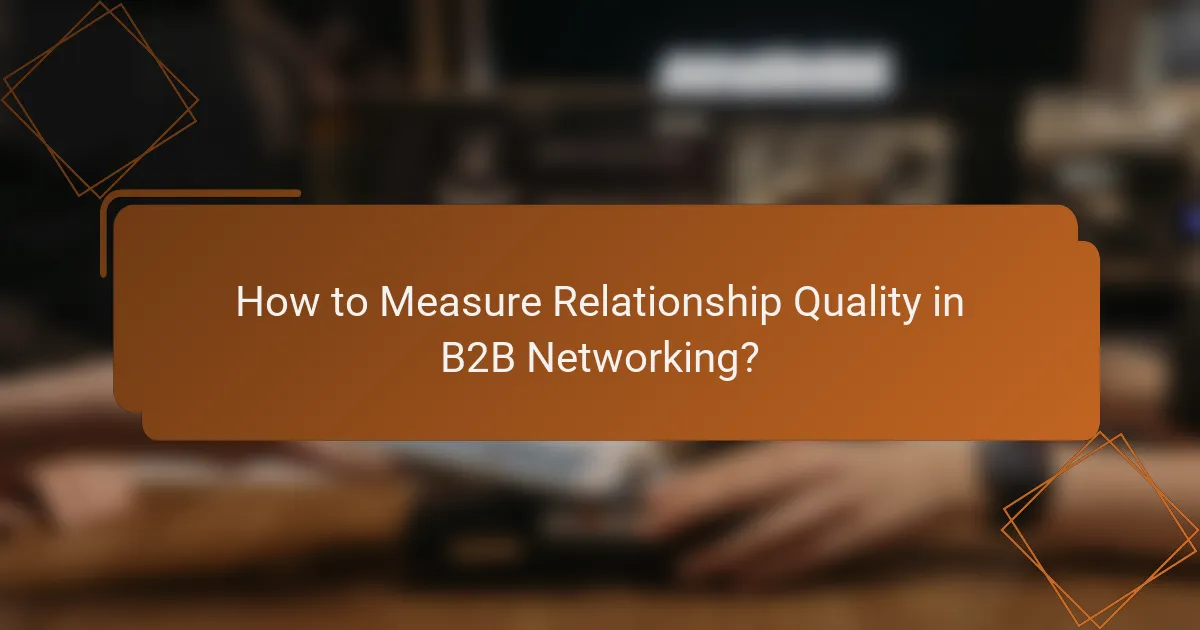In the realm of B2B networking, key metrics play a crucial role in evaluating the quality and success of relationships with partners and clients. By measuring factors such as engagement, feedback, and satisfaction, businesses can gain valuable insights into the effectiveness of their professional networks and enhance their strategic connections.

What Are the Key B2B Networking Metrics?
Key B2B networking metrics help businesses evaluate the quality and success of their relationships with partners and clients. These metrics provide insights into how effectively a company is building and maintaining its professional network.
Relationship strength
Relationship strength measures the depth and quality of connections within your network. Strong relationships often lead to increased trust, collaboration, and mutual support, which can enhance business opportunities.
To assess relationship strength, consider factors like communication frequency, shared goals, and the level of engagement in joint projects. Regular check-ins and feedback can help gauge the health of these connections.
Engagement frequency
Engagement frequency refers to how often you interact with your network contacts. Higher engagement typically indicates a more active and fruitful relationship.
Track interactions through meetings, calls, emails, and social media exchanges. Aim for consistent communication, ideally monthly or quarterly, to maintain visibility and relevance in your network.
Referral rates
Referral rates indicate how often your network refers potential clients or partners to your business. A high referral rate signifies strong trust and satisfaction among your connections.
To improve referral rates, ensure you provide value to your network and ask for referrals when appropriate. Monitor these rates regularly to identify trends and areas for improvement.
Partnership longevity
Partnership longevity measures the duration of relationships within your network. Long-lasting partnerships often reflect successful collaboration and shared values.
Evaluate the lifespan of your partnerships and identify factors contributing to their success. Consider maintaining regular communication and adapting to changes to foster longer-lasting connections.
Return on investment
Return on investment (ROI) assesses the financial benefits gained from networking activities compared to the costs incurred. A positive ROI indicates that your networking efforts are yielding profitable outcomes.
Calculate ROI by comparing the revenue generated from partnerships against the expenses of networking initiatives. Focus on high-impact networking strategies that align with your business goals to maximize returns.

How to Measure Relationship Quality in B2B Networking?
Measuring relationship quality in B2B networking involves assessing various metrics that reflect the strength and effectiveness of connections. Key methods include gathering feedback, analyzing engagement, and utilizing specific scoring systems to gauge satisfaction and loyalty.
Surveys and feedback
Surveys and feedback are direct methods to evaluate relationship quality. They can be conducted through online questionnaires, interviews, or informal discussions, allowing businesses to gather insights on client satisfaction and areas for improvement.
When designing surveys, focus on open-ended questions that encourage detailed responses, as well as closed questions that can provide quantifiable data. Aim for a response rate of at least 20-30% to ensure the feedback is representative.
Net Promoter Score (NPS)
The Net Promoter Score (NPS) is a widely used metric that measures customer loyalty and satisfaction based on a single question: “How likely are you to recommend our service to a colleague?” Responses are scored on a scale from 0 to 10, categorizing customers into promoters, passives, and detractors.
To calculate NPS, subtract the percentage of detractors from the percentage of promoters. A score above 50 is generally considered excellent, while scores below 0 indicate significant issues. Regularly tracking NPS can help identify trends in relationship quality over time.
Engagement analytics
Engagement analytics involve monitoring interactions between businesses and their clients, providing insights into relationship strength. Key metrics include email open rates, response times, meeting frequency, and social media interactions.
Utilizing tools like CRM systems can help track these metrics effectively. Aim for high engagement rates, typically above 20% for email campaigns, and ensure timely responses to inquiries, ideally within 24 hours. Analyzing these patterns can reveal opportunities for deeper connections and areas needing attention.

What Tools Can Help Assess Networking Success?
Several tools can effectively measure networking success by analyzing relationship quality and engagement metrics. These platforms provide insights into interactions, lead generation, and overall effectiveness in building business connections.
LinkedIn Sales Navigator
LinkedIn Sales Navigator is a powerful tool for B2B networking, offering advanced search capabilities to identify potential leads and connections. It allows users to filter prospects based on industry, company size, and other criteria, making it easier to target the right audience.
Utilizing features like InMail and connection recommendations, Sales Navigator helps maintain relationships by facilitating direct communication. Regularly reviewing engagement metrics, such as response rates and connection growth, can provide insights into networking effectiveness.
HubSpot CRM
HubSpot CRM is a comprehensive customer relationship management tool that tracks interactions with contacts and companies. It offers features like email tracking, pipeline management, and reporting, which are essential for assessing the quality of networking efforts.
By analyzing data on contact engagement and deal progress, users can identify which relationships yield the best results. Setting up automated follow-ups and reminders can help maintain connections and enhance relationship quality over time.
Salesforce
Salesforce is a leading CRM platform that provides extensive tools for managing customer relationships and networking efforts. Its customizable dashboards and reporting features allow users to track key performance indicators related to networking success.
Salesforce enables users to analyze metrics such as lead conversion rates and customer satisfaction scores. Regularly reviewing these metrics can help businesses refine their networking strategies and focus on high-value relationships that drive success.

What Are the Best Practices for Improving Networking Metrics?
Improving networking metrics involves implementing strategies that enhance relationship quality and measure success effectively. Key practices include regular follow-ups, personalized communication, and active participation in networking events.
Regular follow-ups
Regular follow-ups are essential for maintaining and strengthening business relationships. Schedule these interactions at consistent intervals, such as every few weeks or monthly, to ensure ongoing engagement.
Utilize various communication channels like email, phone calls, or social media to keep the conversation going. A simple check-in can lead to valuable insights and opportunities for collaboration.
Personalized communication
Personalized communication fosters deeper connections and shows that you value the relationship. Tailor your messages based on the recipient’s interests, past interactions, and specific needs.
For instance, referencing a recent achievement of their company or sharing relevant industry news can make your outreach more meaningful. Avoid generic messages; instead, aim for a personal touch that resonates with the recipient.
Networking events participation
Actively participating in networking events is a powerful way to enhance your networking metrics. Attend industry conferences, trade shows, and local meetups to connect with potential partners and clients.
When attending these events, set specific goals, such as meeting a certain number of new contacts or scheduling follow-up meetings. This focused approach can significantly improve your networking outcomes and relationship quality.

How Do Industry Differences Affect Networking Metrics?
Industry differences significantly influence the metrics used to assess networking effectiveness and relationship quality. Each sector has unique characteristics that dictate which metrics are most relevant, how they are measured, and what success looks like.
Tech industry metrics
In the tech industry, networking metrics often focus on speed and efficiency. Key performance indicators (KPIs) include response times, lead conversion rates, and the number of partnerships formed within a specific timeframe. For example, a successful tech networking event might aim for a lead conversion rate of 20-30% within three months.
Additionally, metrics such as user engagement on platforms like LinkedIn or GitHub can provide insights into relationship quality. Tracking interactions, such as comments and shares, helps gauge the strength of connections. Regularly reviewing these metrics can help tech companies refine their networking strategies.
Healthcare industry metrics
In the healthcare sector, networking metrics emphasize collaboration and patient outcomes. Important metrics include referral rates, partnership longevity, and shared research initiatives. For instance, a healthcare organization might track the percentage of referrals that lead to successful patient outcomes, aiming for a rate above 75%.
Moreover, compliance with regulations such as HIPAA in the U.S. is crucial when assessing networking success. Ensuring that partnerships adhere to these standards not only protects patient information but also enhances trust among stakeholders. Regular audits and feedback loops can help maintain high-quality relationships in this sensitive industry.
